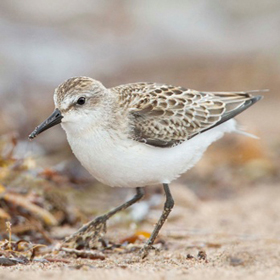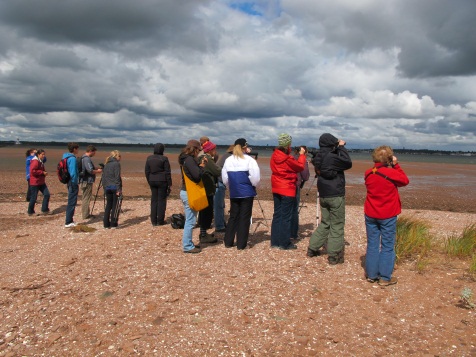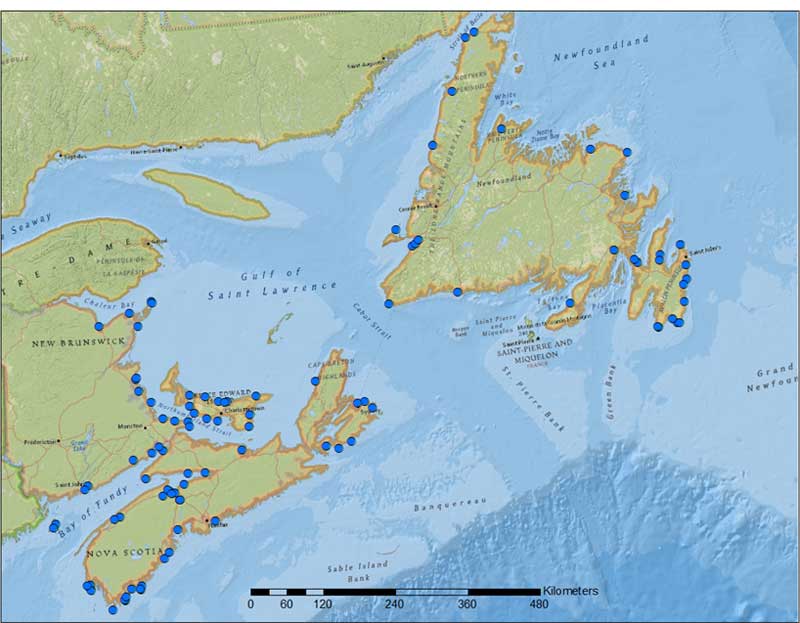Atlantic Canada Shorebird Survey

The Atlantic Canada Shorebird Survey is part of the Program for Regional and International Shorebird Monitoring. It was originally developed in 1974 as the Maritimes Shorebird Survey by Canadian Wildlife Service scientists along with similar surveys in the province of Ontario (Ontario Shorebird Survey) and the northeastern United States (International Shorebird Survey). In 2003, the Maritimes Shorebird Survey became the Atlantic Canada Shorebird Survey to include Newfoundland and Labrador.
Initially, the principal objective of the Maritimes Shorebird Survey was to identify and document areas of major importance to migratory shorebirds in the Maritime Provinces. In 1974, the survey consisted of a coordinated series of counts carried out at only 17 coastal sites, but since then over 500 Atlantic Canada Shorebird Survey volunteers have collected data from more than 650 sites. Today, regular data collection at more than 100 Atlantic Canada Shorebird Survey sites is still coordinated by the Canadian Wildlife Service of Environment and Climate Change Canada as a volunteer-based survey that relies on the skills, dedication and long-term support of birders throughout Atlantic Canada.
Join the Atlantic Canada Shorebird Survey!
To contact us you can...
Send an email to the Shorebird Survey coordinator at:
Shorebird Biologist
Canadian Wildlife Service
Environment and Climate Change Canada
17 Waterfowl Lane
Sackville NB, E4L 1G6
Or give us a call at
506-364-5037
Based on the analysis of shorebird migration data (1974-2009), it is estimated that of the 32 species that stop-over in Atlantic Canada during migration, (Table 1), 19 are experiencing declining population trends (see Status of Birds in Canada), 79% of which have a Canadian Responsibility score of Moderate, High or Very High. Several of these shorebird species have been assessed by the Committee on the Status of Endangered Wildlife in Canada and listed under the Species at Risk Act.

Atlantic Canada Shorebird Survey volunteers enjoy bird watching but also understand the importance of following a survey protocol to collect information that can be used to help better understand and conserve birds. Skill levels vary and new volunteers are given tools and support to help them learn to identify and census shorebird species.
A number of workshops have been given to interested groups throughout Atlantic Canada, often in collaboration with conservation partners (Nature Conservancy of Canada, Canadian Parks and Wilderness Society, Naturalist Clubs, Wildlife and Nature Trusts, National Parks, Provincial Parks, Universities, Municipalities, etc.). Please contact the Canadian Wildlife Service or one of our partner organizations for more information on these workshops.
Atlantic Canada Shorebird Survey sites can be selected by newly recruited volunteers with the help of the Atlantic Canada Shorebird Survey coordinator. They can be portions of beaches, tidal mudflats or sandflats, saltmarshes, freshwater marshes, or fields for upland species.
Often, sites that have been monitored for many years become available to new volunteers, while other sites have been newly added to the Atlantic Canada Shorebird Survey to help expand the scope of the survey (Figure 1). These new sites, along with traditional Atlantic Canada Shorebird Survey sites, will provide us with the data we need to assess population trends and habitat use for shorebirds that migrate through Atlantic Canada.

Long description for Figure 1
Figure 1 is a map of Atlantic Shorebird Survey Sites. One hundred new sites were randomly selected in Atlantic Canada based on site accessibility and shorebird density. Sites in Labrador were excluded due to limited accessibility to most potential shorebird stop-over sites.
Atlantic Canada Shorebird Survey counts are conducted between July 20th and November 20th each year. And although spring migration does not produce high shorebird numbers or diversity in Atlantic Canada, interested contributors can also conduct surveys between April 20th and June 9th. During these periods, volunteers visit their site once every 10 days to count and identify all shorebirds observed. In general, the more counts that are made at an Atlantic Canada Shorebird Survey site, and the longer the record of years, the more valuable the census series becomes as a scientific record.

Atlantic Canada Shorebird Survey data is collected throughout the survey period and at the end of the field season, the data is sent to the Atlantic Canada Shorebird Survey coordinator or uploaded by volunteers via the online data entry portal. The Atlantic Canada Shorebird Survey database can then be used for research and conservation purposes by Environment and Climate Change Canada, provincial governments, academics, students, non-governmental organizations and other interested groups.
New volunteers are always needed to survey areas with low coverage or to take over from retiring volunteers. If you are interested in contributing to the Atlantic Canada Shorebird Survey or would like more information, please contact us (see contact information above). We will provide you with data sheets, guidelines and all the information you need to get started.
| Common name | Scientific name | Stops-over in Atlantic Canada during migration? |
|---|---|---|
| American Oystercatcher | Haematopus palliatus | Yes, and also breeds in small numbers |
| Black-bellied Plover | Pluvialis squatarola | Yes |
| American Golden Plover | Pluvialis dominica | Yes |
| Semipalmated Plover | Charadrius semipalmatus | Yes |
| Piping Plover melodus | Charadrius melodus melodus | Yes, and also breeds here |
| Killdeer | Charadrius vociferus | Yes, and also breeds here |
| Spotted Sandpiper | Actitis macularius | Yes, and also breeds here |
| Solitary Sandpiper | Tringa solitaria | Yes |
| Greater Yellowlegs | Tringa melanoleuca | Yes |
| Willet | Tringa semipalmata | Yes, and also breeds here |
| Lesser Yellowlegs | Tringa flavipes | Yes |
| Upland Sandpiper | Bartramia longicauda | Yes, and also breeds in small numbers |
| Whimbrel | Numenius phaeopus | Yes |
| Hudsonian Godwit | Limosa haemastica | Yes |
| Ruddy Turnstone | Arenaria interpres | Yes |
| Red Knot rufa | Calidris canutus rufa | Yes |
| Stilt Sandpiper | Calidris himantopus | In small numbers |
| Sanderling | Calidris alba | Yes |
| Dunlin | Calidris alpina | Yes |
| Purple Sandpiper | Calidris maritima | Yes, and also winters here |
| Baird's Sandpiper | Calidris bairdii | In small numbers |
| Least Sandpiper | Calidris minutilla | Yes |
| White-rumped Sandpiper | Calidris fuscicollis | Yes |
| Buff-breasted Sandpiper | Calidris subruficollis | In small numbers |
| Pectoral Sandpiper | Calidris melanotos | Yes |
| Semipalmated Sandpiper | Calidris pusilla | Yes |
| Short-billed Dowitcher | Limnodromus griseus | Yes |
| Wilson's Snipe | Gallinago delicata | Yes, and also breeds here |
| American Woodcock | Scolopax minor | Yes, and also breeds here |
| Wilson's Phalarope | Phalaropus tricolor | Yes, and also breeds in small numbers |
| Red-necked Phalarope | Phalaropus lobatus | Yes |
| Red Phalarope | Phalaropus fulicarius | Yes |